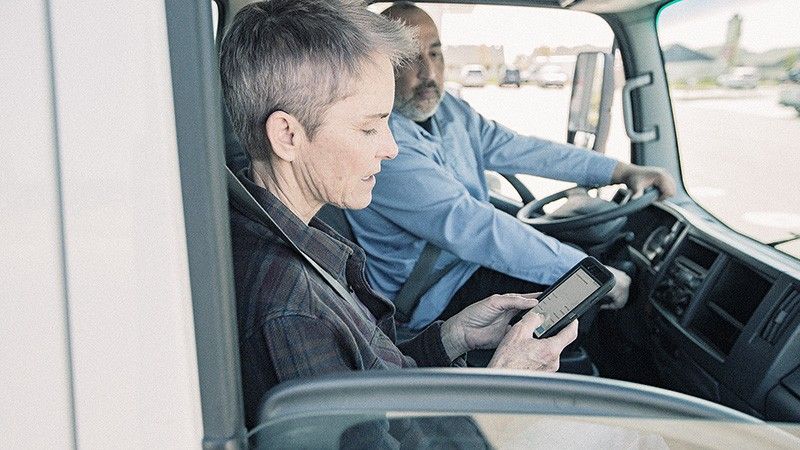Stay connected
Subscribe to our Inside WEX blog and follow us on social media for the insider view on everything WEX, from payments innovation to what it means to be a WEXer.

Technology has contributed to the trucking industry in many ways, from logistics capabilities and supply chain management to mobile apps and driverless trucks – but fleet communications have benefited most from the advancements. Efficiencies in scheduling, inventory, and payment, all aspects of fleet communications, have enabled the trucking industry to save millions and tackle its biggest challenge — the driver shortage.
Used correctly, information can help fleets achieve better load matches, improve routing, and overcome structural challenges such as the ever-present driver shortage. “If our industry could get just 5% more efficiency out of our operations, it could possibly eliminate the driver shortage entirely.”
Some would say that information technology has become what it is today because of our mobile devices. Fleet communications are not limited to direct interaction with fleet mobile or fleet networks. They can also be found on Twitter, Facebook, and Instagram. And as truck drivers get more comfortable with smart phones and handhelds, they are also using social media more and more. They use their phones to stay connected with the industry and fleet networks and with their family and friends. They use social media to read the news of the day and to stay on top of weather and traffic alerts. Fleet managers and operators use these various channels for driver recruitment and for brand awareness and to highlight company culture. They use it as a way to find reliable vendors and provide feedback on those that are less reliable. They even use it for referrals for financial or factoring solutions.

Fleet owners are continually challenged to find effective channels for advertising because they often don’t know how to find their audiences. But social media is helping them find better ways to target those audiences and make effective use of the metrics available to them.
79.9% of company drivers and 69.7% of owner-operators use social media, with the most used being Facebook and YouTube.
Studies show that smartphone users check Facebook an average of 14 times a day – and those rates are even higher with Instagram users ages 18-29. The industry needs to reach millennials, and they have found that social media is the answer and targeted advertising is key.
By using targeted demographics, behavioral buying patterns, and specific interests – all information easily found on social media platforms – advertisers are better able to reach and even convert their audiences. While the targeted social media content might cast a wide net, it is still important to pinpoint the exact kind of drivers you are looking for. Fleet databases can be an invaluable component of fleet communications, and then for marketing and advertising, they can really get specific, helping you to reach the exact demographic you are trying to get to. A comprehensive strategy that includes social platforms along with email addresses and phone numbers will aid in narrowing the audience to find the people most relevant to the ad or promotion.
Organic posting on dedicated company pages or sharing within defined communities and social networks is helpful in creating interest and awareness, but alone may take longer to reach specific audiences. Certain algorithm strategies can increase the efficacy of an organic post. For example, an organic post with a set strategy for respondent language and timing can create activity that tends to expand audiences. This approach has become common with start-up companies but is probably not going to be effective in the realm of fleet communications.
Paid social media buying has become an entire industry in and of itself. With platforms like Google, Facebook, YouTube, and Instagram, the opportunities are vast – though challenging – which is why companies have sprung up that make it their business to help navigate the best strategies for paid social media. Digital media has come a long way and fleet communications have begun to adopt the service in an attempt to find and speak to the right audiences. Additionally, digital media allows companies to create their own message and design their own ads allowing the viewer to take action on the specific ask. Paid media can also help to build brand awareness, also important to the trucking industry. Fleet communications have made a concerted effort to convey company values, benefits, and personality because they know brand and culture have become some of the most important aspects attracting drivers.
While social media has become an important and effective way to reach audiences, it is not always clear which platforms will best meet specific fleet needs. We do know, however, that millennials are a priority and millennials are on Instagram.
Although Facebook and YouTube have been the most popular social channels within the trucking industry and for fleet communications, Instagram provides a broader audience and is ideal for recruiting.

Instagram allows you to build your brand presence to showcase culture in hopes of attracting younger drivers and employees. It provides the opportunity to speak to your audience with purpose and clarity through image and video, the most dynamic way to connect with this audience. Fleet communications are taking on new meaning and being shaped by the audience they are trying to reach. Hashtags, photos, and videos are common on most platforms, but they are most specific to Twitter and Instagram, with conversion rates in advertising at heretofore unimaginable levels.
While mobile devices are common and social media engagement is rampant in fleet communications, developing and maintaining a social media presence is more than just networking. And unless it is organic, it is not free. Building and maintaining a social marketing effort can require considerable resources in cash flow and paid salaries. Many small companies may not have the funding to wield a robust social media strategy, which is why they are turning to freight factoring partners like Fleet One for help. Freight factoring can make sure cash flow is available to implement a marketing strategy that will help grow the business. No matter how small or large your trucking company, freight factoring can help build a social media presence and an advertising strategy to attract talent, bring greater brand awareness, and grow your business. So even if you don’t think you can afford it, companies like Fleet One Factoring are there to help.
RESOURCES:
https://www.ezinvoicefactoring.com/social-media-for-trucking-companies
Subscribe to our Inside WEX blog and follow us on social media for the insider view on everything WEX, from payments innovation to what it means to be a WEXer.